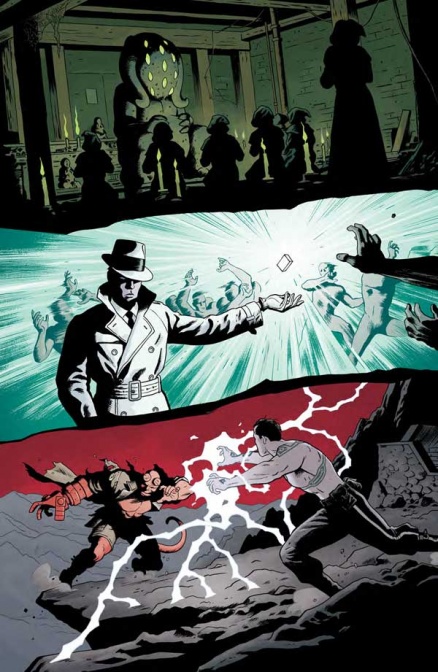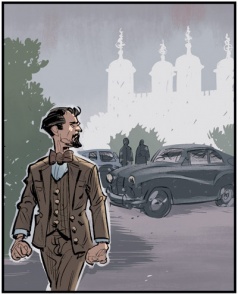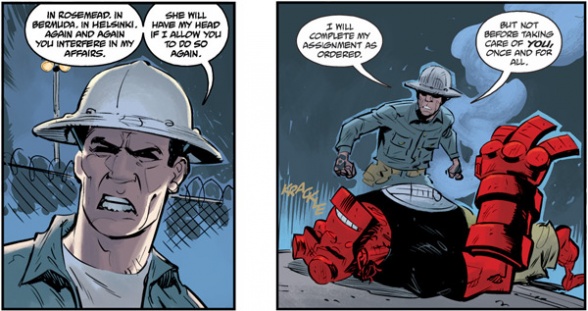
Secret paranormal societies, Cold War era, the South Pacific, Hellboy, and a giant turtle monster… What more could you want?
Written by Mike Mignola and Chris RobersonCover by Pablo Rivera
Illustrated by Brian Churilla
Colored by Dave Stewart
Lettered by Clem RobinsThe mystery in the tropics heats up when a monster attacks, but the creature may have ties to a secret weapon at the center of an international conflict. Elsewhere, Bruttenholm’s own investigation suggests that the B.P.R.D. is embroiled in something much larger than he thought.
Christopher Lewis: We’re back in the South Pacific with Hellboy and gang. Out of the gate out I was happy to see this issue picked up immediately where the last issue’s cliffhanger left off… Hellboy fighting a giant, mutated turtle monster. To take it to the next level Brian Churilla nailed the action sequence. What did you think Mark?
Mark Tweedale: I agree. And I must admit, I couldn’t help but smile at the bit about Hellboy’s boots, especially after our commenting about them in our last review. Plus it gave the sequence a nice bit of character. I had a lot of fun with this one. Stories like this, with the cast split up, work better in a longer miniseries, so I’m glad this has three issues to breathe a bit. It gives enough room to touch base with Sue’s plotline and Bruttenholm’s investigations—both of which are much more mood focused—while keeping the energy up with Hellboy, Archie, and Stegner’s scenes. The pacing in this issue was great.
The turtle scene was the highlight though.
Chris: I do have to comment on the tearing of Hellboy’s boots and some of the continuity issues we discussed in our last review between the first issue of “Occult Intelligence” and “Secret Nature.” After reading this issue it occurred to me that some of the problems we noted last time (Hellboy wearing human boots again, the under utilization of the Woodrow character, etc.) would be less noticeable and make more sense if “Secret Nature” was read after “Occult Intelligence.” For example, the tearing of Hellboy’s boots here would logically lead to him not wearing human boots in “Secret Nature” versus the Hellboy going back to wearing human boots in “Occult Intelligence.”
While changing the reading order wouldn’t fix all of the things we noted, it would make them less prominent and allow for better flow across storylines. Did this come to mind for you too?
Mark: It did, actually. I immediately wondered if the order would be reversed for the trade—it wouldn’t be the first time; “Lobster Johnson” regularly shuffles its short stories around for the trades after all—however, I quickly remembered “Secret Nature” is set in March, whereas “Occult Intelligence” is set in September, so unless they change something, that’s not gonna happen. I dunno. Perhaps they’ll change the art in the panels where Hellboy’s boots can be seen. I guess we’ll have to wait and see.
How’d you find Bruttenholm’s section of the “Occult Intelligence”? I know our last review, we spent a significant portion talking about how the removal of outer line drew attention or changed the mood of a scene, and I wanted to mention it again because I found it really worked in Bruttenholm’s scenes. Especially when he was on the streets of London, it evoked a feeling of fog—not necessarily a literal fog, but there’s a layer between Bruttenholm obscuring the world from him. Considering he’s digging into the mysterious S.I.D., it matched the mood perfectly. I thoroughly enjoyed what Brian Churilla and Dave Stewart did there.
Chris: Overall I thought this coloring technique worked significantly better here than in the last issue, and it never appeared distracting.
And you’re right about the Bruttenholm scenes being greatly enhanced by Stewart’s coloring technique. All of those scenes had something unique and special about them, especially the one where Bruttenholm was searching around the streets on London. Something interesting though, while the coloring and lack of outline in that scene gave you the feeling of fog, it instead gave me the impression that the scene was taking place at dusk as dim light would make the background and peripheral objects less pronounced. I love that we saw this differently as it truly shows the richness of Churilla and Stewart’s art to allow people to interpret the imagery in their own way.
Continued belowMark: It’s non-specific in that way, used to evoke and suggest, which works well for a scene where Bruttenholm himself is uncertain. I’m gonna dive into spoilers now. Enkeladite is back. Personally, I think this barely classifies as a spoiler since it’s been signposted for a while now—Hellboy’s been name-dropping Enkeladite for a while now, just to keep it fresh in our minds, so we all knew as soon as the Russians from “Beyond the Fences” showed up again that Enkeladite would probably be a part of the picture too.
I’m very curious to see how this element will be developed, especially given what we know about it from “B.P.R.D.: 1948” both in 1948 and the flashforward to 1983. After all, by 1983 the events of 1948 had been declassified, and it was explicitly said that there were never any other reports of monsters showing up at other nuclear testings… yet here we are at another testing site, a mere seven years after the Carmelo Air Force Base incident, and there are monsters and Enkeladite. However events unfold, it would seem the events on the Marshall Islands were not yet declassified by 1983.
Chris: I’m with you, and will also be interested to see if there was any past paranormal activity associated to these islands. In “B.P.R.D.: 1948” Bruttenholm theorized that the Enkeladite issue was the effect of nuclear testing mixed with a past paranormal event that had occurred near the blast site (from the events of “Witchfinder: Lost and Gone Forever”), but his theory had no evidence to back it up. I hope in the next issue we learn something more about the islands to validate or invalidate that theory.
Mark: Yeah, especially given how Bruttenholm steamrolled Dr. Rieu in “1948.” I think he needs his beliefs to be shaken up to evolve as a character.
Chris: Jumping back to the U.K. plotline, I was surprised that Susan had a vision next to an Indian statue that appeared to be a representation of Hecate, as the statue appeared to be the catalyst of her premonition. I always hope that Hecate will show up in Mignolaverse stories, but was surprised that it was in the form of a statue in the home of a B.P.R.D. ally.
Mark: Well, Hecate’s interesting in that she’s been many goddesses in many different cultures, and at this point in the Bureau’s history, I’m not sure they know her significance yet. Also, Dr. Sandhu is an academic in this area, so the statue isn’t necessarily an object of worship, but more likely an object of curiosity. Given her brother’s encounter with the Black Flame in 1923 (Chris Roberson confirmed their familial relationship in an interview last year, and it is somewhat reinforced in this issue with the portrait of the two siblings in Dr. Sandhu’s home), I think she has good reason to be digging into what really happened there. It probably has quite a bit to do with her joining the Bureau in the first place.
Susan’s vision here caught me by surprise. Was that Liz she saw? I mean, it could be…
(Awesome panel by Churilla there.) Anyway, this obviously raised a big question for me. We’ve never been told why Liz has the powers she has, although “Rise of the Black Flame” hinted at enough of an answer that i felt like I didn’t need any more than that. But if that was Liz in Susan’s vision, I’m beginning to think Roberson has much more he wants to say about her and her connection to the Black Goddess.
Of course, Liz normally wears a cross, so who this woman is remains ambiguous.
Chris: Interesting as I didn’t pick up the Sandhu connection between this and the “Rise of the Black Flame” storyline. Something I have said before, and I am sure that I will continue to say, is that all of these connections between storylines are what make the Mignolaverse so great.
Considering that panel, when I saw it I thought Susan was seeing herself in the future and her hair had grown out. I would honestly love for that woman to be Liz as it would bridge the gap between the 1950s and the future, but I don’t think it is her. I can’t recall Liz ever wearing a t-shirt like that, and I don’t think I have ever seen anybody wear a BPRD shirt with a large logo on the front outside of the 1950’s and 1960’s stories (possibly in the very early Hellboy stories). Since Liz didn’t become a ward of the BPRD until the 1970’s I don’t think it’s her, but you never know. I am sure we will find out as the visions start to play a bigger part in the story going forward.
Continued belowMark: It’ll be interesting to see what they’ve got planned for Susan. And there’s obviously a lot in those visions. Do you remember the ones she had at the end of “Beyond the Fences” after coming into contact with Enkeladite-infected tissue?

I’m pretty sure that first panel is Ana Mireya Fierro’s cult worshipping Zara-Hem, and the second panel is certainly Michael Mathers taking out the Zara-Hem cult in 1978 from “The Visitor: How and Why He Stayed” #3. So I’m guessing Zara-Hem and Enkeladite are connected somehow, and perhaps may have been connected as far back as 1948 without Bruttenholm or Rieu even realising.
That last panel with Hellboy and Moravec Valentin fighting is interesting too, especially since “Occult Intelligence” #2 shows the two of them fighting for the first time. I don’t think it’ll escalate to the moment shown in Susan’s vision from “Beyond the Fences”—it’s much too soon for that and it’d be very unsatisfying—but I do like that we’re seeing ‘Round 1’ of a conflict that’ll evolve over several stories.
Chris: The Zara-Hem connection to the Enkeladite is interesting and I am going to have to continually evaluate it going forward. Anything else you want discuss before we wrap up?
Mark: I still find myself pulled out of the story by overly chatty villainous dialogue.
Dialogue of this sort has the exact opposite effect than I’m guessing was intended—to increase tension. Instead, it dissolves tension and makes the villains less interesting, which is a shame given how much better Moravec was written in “Beyond the Fences.” I think Roberson could write these moments better, instead of relying on clichés. Yes, I know they are economical ways to push the story in certain directions, but they often damage the tone of the scene.
It had a minimal impact on this issue of “Occult Intelligence” overall, but it stuck in my mind because it was the closing scene of the issue, and I remember how badly “Ghost Moon” stumbled. So with that in mind, I’m giving this a 7.5. The art was the high point for me and the pacing was certainly an improvement over the last issue, but I still find the dialogue rocky. Especially with multi-arc characters like Moravec, I need a real character to engage with, and I’m nervous about #3.
Chris: For me the writing was fun, moved the story along, and was well paced. However, Churilla and Stewart’s art is what took this issue to the next level. Especially the turtle monster scene and use of the coloring technique to enhance mood throughout the story. Therefore I am going to have to give this one an 8, mainly for the art.
Final verdict: 7.75 – An improvement from the first issue that continues grow the larger narrative of the B.P.R.D.’s early years. Churilla’s art is the highlight.











